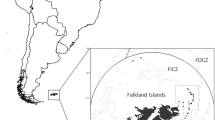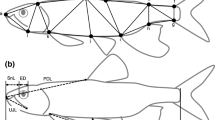Abstract
Allometric scaling analysis was employed to investigate the consequences of size evolution on hydrodynamic performance and ecology in the white shark Carcharodon carcharias. Discriminant analysis using the power equation y=axb was negative for caudal fin span (S) versus fork length (FL) in C. carcharias. In contrast in two delphinid species, Delphinus capensis and Tursiops aduncus, the span of the flukes versus fork length rises in positive allometric fashion, and strong positive allometry of S versus √A (area) was also recorded. The latter reflects a high lift/drag ratio. S versus √A in C. carcharias displays negative allometry and consequently a lower lift/drag ratio. A lower aspect ratio (AR) caudal fin in C. carcharias compared to that of the delphinids (mean 3.33 and 4.1, respectively) and other thunniform swimmers provides the potential for better maneuverability and acceleration. The liver in sharks is frequently associated with a buoyancy function and was found to be positively allometric in C. carcharias. The overall findings suggest that the negatively allometric caudal fin morphometrics in C. carcharias are unlikely to have deleterious evolutionary fitness consequences for predation. On the contrary, when considered in the context of positive liver allometry in C. carcharias it is hereby suggested that buoyancy may play a dominant role in larger white sharks in permitting slow swimming while minimizing energy demands needed to prevent sinking. In contrast hydrodynamic lift is considered more important in smaller white sharks. Larger caudal fin spans and higher lift/drag ratio in smaller C. carcharias indicate greater potential for prolonged, intermediate swimming speeds and for feeding predominantly on fast-moving fish, in contrast to slow-swimming search patterns of larger individuals for predominantly large mammalian prey. Such data may provide some answers to the lifestyle and widespread habitat capabilities of this still largely mysterious animal.


Similar content being viewed by others
References
Alexander MR (1990) Size, speed and buoyancy adaptations in aquatic animals. Am Zool 30:189–196
Arata GFA (1954) A contribution to the life history of the swordfish, Xiphias gladius Linnaeus, from the South Atlantic Coast of the United States and Gulf of Mexico. Bull Mar Sci Gulf Caribb 4:183–243
Boustany AM, Davis SF, Pyle P, Anderson SD, Le Boeuf BJ, Block B (2002) Expanded niche for white sharks. Nature 415:35–36
Bruce BD (1992) Preliminary observations in the biology of the white shark, Carcharodon carcharias, in south Australian waters. Aust J Mar Freshw Res 43:1–11
Cliff G, Dudley SFJ, Davis B (1989) Sharks caught in the protective gill nets off Natal, South Africa 2. The great white shark Carcharodon carcharias (Linnaeus). S Afr J Mar Sci 8:131–144
Daniel T, Jordan C, Grunbaum D (1992) Hydromechanics of swimming. In: Alexander RM (ed) Comparative and environmental physiology 2. Mechanics of animal locomotion. Springer, Berlin Heidelberg New York, pp 17–49
Darveau C-A, Suarez RK, Andrews RD, Hochachka PW (2003) Physiology (communication arising (reply)): why does metabolic rate scale with body size?/Allometric cascades. Nature 421:714
Donley J, Sepulveda CA, Konstantinidis P, Gemballa S, Shadwick RE (2004) Convergent evolution in mechanical design of lamnid sharks and tunas. Nature 429:61–65
Drucker EG (1996) The use of gait transition speed in comparative studies of fish locomotion. Am Zool 36:555–566
Fish FE (1998a) Biomechanical perspective on the origin of cetacean flukes. In: Thewissen JGM (ed) The emergence of whales. Plenum, New York, pp 303–324
Fish FE (1998b) Comparative kinematics and hydrodynamics of odontocete cetaceans: morphological and ecological correlates with swimming performance. J Exp Biol 201:2867–2877
Fish FE, Shannahan LD (2000) The role of the pectoral fins in body trim of sharks. J Fish Biol 56:1062–1073
Froese R, Pauly D (2002) Fishbase. World Wide Web electronic publication. http://www.fishbase.org
Kramer DL, McLaughlin RL (2001) The behavioral ecology of intermittent locomotion. Am Zool 41:137–153
Lingham-Soliar T (2001) The ichthyosaur integument: skin fibers, a means for a strong, flexible and smooth skin. Lethaia 34:287–302
Lingham-Soliar T (2005) Dorsal fin in the white shark Carcharodon carcharias: a dynamic stabilizer for fast swimming. J Morphol 263:1–11
Motani R (2002) Scaling effects in caudal fin propulsion and the speed of ichthyosaurs. Nature 415:309–312
Phleger CF (1998) Buoyancy in marine fishes: direct and indirect role of lipids. Am Zool 38:321–330
Popper KR (1985) Popper selections. Princeton University Press, Princeton
Sfakiotakis M, Lane DM, Davies JBC (1999) Review of fish swimming modes for aquatic locomotion. IEEE J Oceanic Eng 24:237–252
Strong WR (1996) Repetitive aerial gaping: a thwart induced behavior in white sharks. In: Klimley AP, Ainley DG (eds) Great white sharks: the biology of Carcharodon carcharias. Academic, San Diego, pp 393–400
Strong R, Murphy RC, Bruce BD, Nelson DR (1992) Movements and associated observations of bait-attracted white sharks, Carcharodon carcharias: a preliminary report. Aust J Mar Freshw Res 43:13–20
Thomson KS, Simanek DE (1977) Body form and locomotion in sharks. Am Zool 17:343–354
Tricas TC, McCosker JE (1984) Predatory behavior of the white shark (Carcharodon carcharias), with notes on its biology. Proc Calif Acad Sci 43:221–238
Van Dam CP (1987) Efficiency characteristics of crescent-shaped wings and caudal fins. Nature 325:435–437
Webb PW (1984) Form and function in fish swimming. Sci Am 251:58–68
Webb PW (1997) Swimming. In: Evans DH (ed) The physiology of fishes. CRC Press, New York, pp 3–24
Wilga CD, Lauder GV (2002) Three-dimensional kinematics and wake structure of the pectoral fins during locomotion in leopard sharks Triakis semifasciata. J Exp Biol 203:2261–2278
Acknowledgements
I am grateful to the Director of Natal Sharks Board (NSB) and Geremy Cliff (NSB) for material and data used in the present study. I am particularly grateful for the constructive comments by the three anonymous reviewers that have greatly benefited the paper.
Author information
Authors and Affiliations
Corresponding author
Additional information
An erratum to this article can be found at http://dx.doi.org/10.1007/s00114-005-0642-0
Rights and permissions
About this article
Cite this article
Lingham-Soliar, T. Caudal fin allometry in the white shark Carcharodon carcharias: implications for locomotory performance and ecology. Naturwissenschaften 92, 231–236 (2005). https://doi.org/10.1007/s00114-005-0614-4
Received:
Accepted:
Published:
Issue Date:
DOI: https://doi.org/10.1007/s00114-005-0614-4




